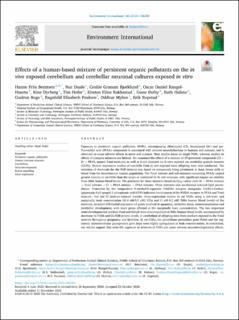| dc.description.abstract | Exposure to persistent organic pollutants (POPs), encompassing chlorinated (Cl), brominated (Br) and perfluoroalkyl acid (PFAA) compounds is associated with adverse neurobehaviour in humans and animals, and is observed to cause adverse effects in nerve cell cultures. Most studies focus on single POPs, whereas studies on effects of complex mixtures are limited. We examined the effects of a mixture of 29 persistent compounds (Cl + Br + PFAA, named Total mixture), as well as 6 sub-mixtures on in vitro exposed rat cerebellar granule neurons (CGNs). Protein expression studies of cerebella from in vivo exposed mice offspring were also conducted. The selection of chemicals for the POP mixture was based on compounds being prominent in food, breast milk or blood from the Scandinavian human population. The Total mixture and sub-mixtures containing PFAAs caused greater toxicity in rat CGNs than the single or combined Cl/Br sub-mixtures, with significant impact on viability from 500x human blood levels. The potencies for these mixtures based on LC50 values were Br + PFAA mixture > Total mixture > Cl + PFAA mixture > PFAA mixture. These mixtures also accelerated induced lipid peroxidation. Protection by the competitive N-methyl-D-aspartate (NMDA) receptor antagonist 3-((R)-2-Carboxypiperazin-4-yl)-propyl-1-phosphonic acid (CPP) indicated involvement of the NMDA receptor in PFAA and Total mixture-, but not Cl mixture-induced toxicity. Gene-expression studies in rat CGNs using a sub-toxic and marginally toxic concentration ((0.4 nM-5.5 µM) 333x and (1 nM-8.2 µM) 500x human blood levels) of the mixtures, revealed differential expression of genes involved in apoptosis, oxidative stress, neurotransmission and cerebellar development, with more genes affected at the marginally toxic concentration. The two important neurodevelopmental markers Pax6 and Grin2b were downregulated at 500x human blood levels, accompanied by decreases in PAX6 and GluN2B protein levels, in cerebellum of offspring mice from mothers exposed to the Total mixture throughout pregnancy and lactation. In rat CGNs, the glutathione peroxidase gene Prdx6 and the regulatory transmembrane glycoprotein gene Sirpa were highly upregulated at both concentrations. In conclusion, our results support that early-life exposure to mixtures of POPs can cause adverse neurodevelopmental effects. | |
